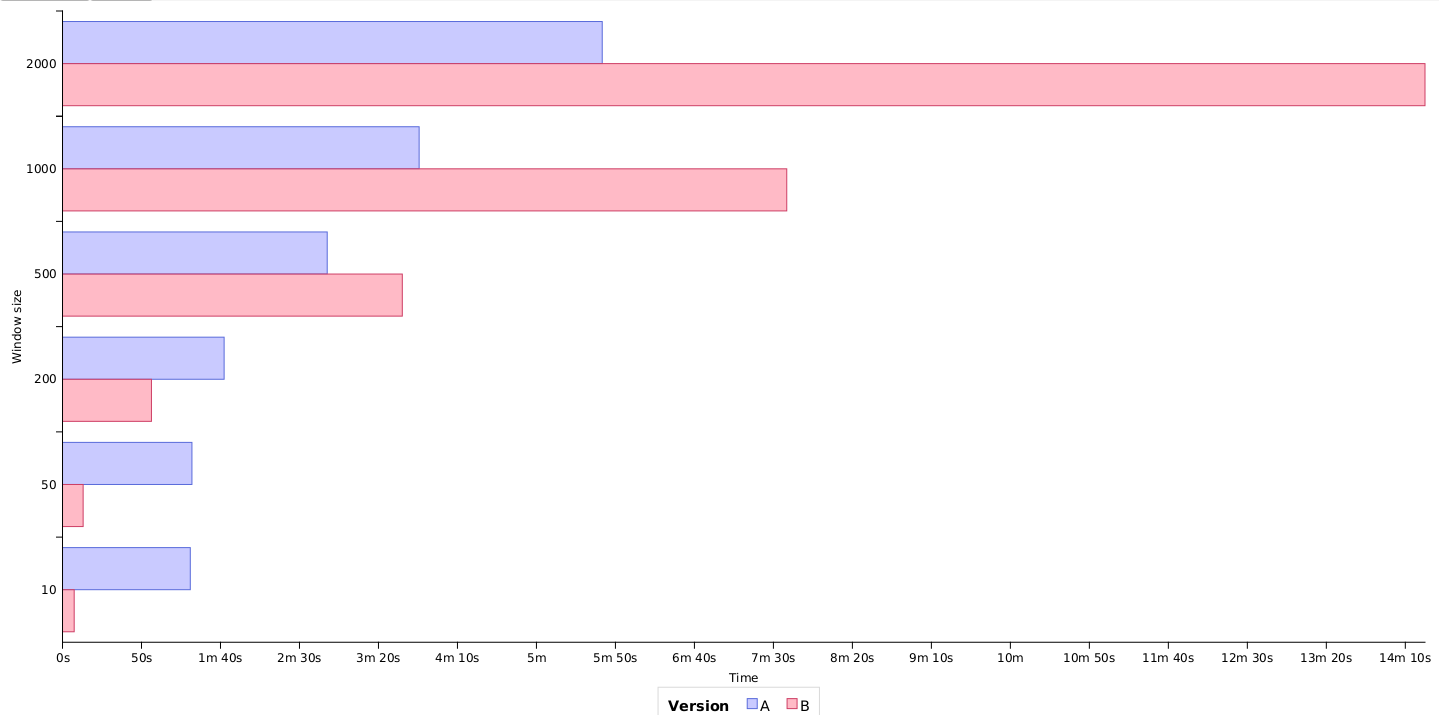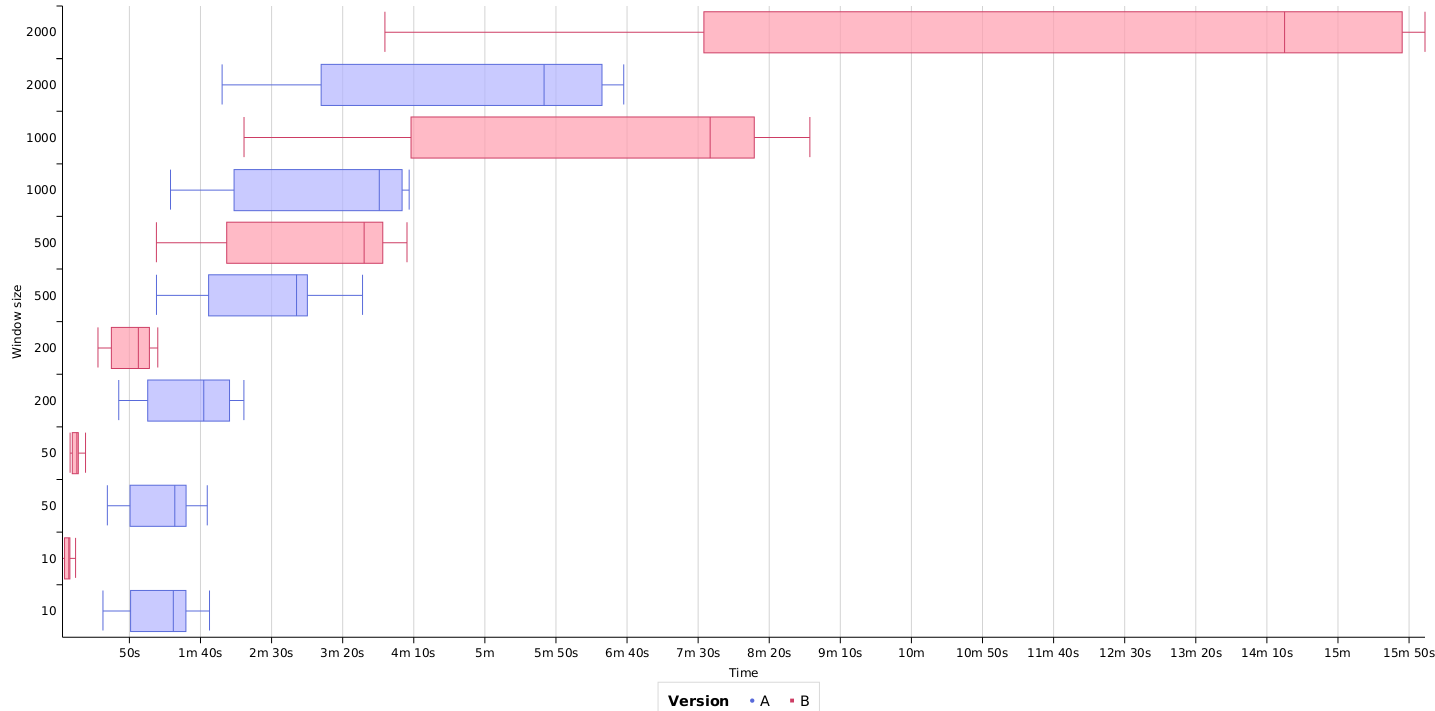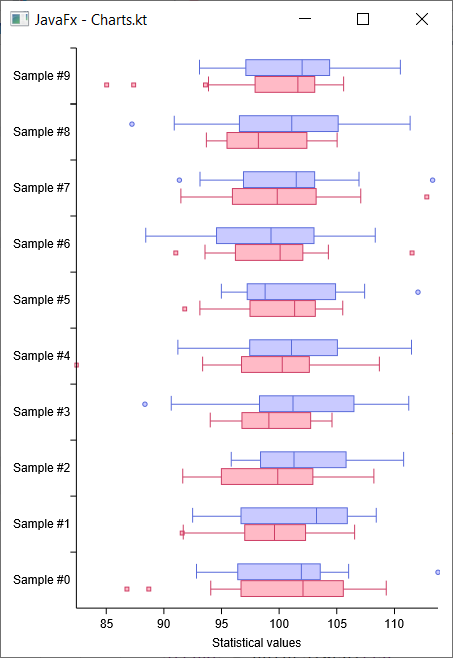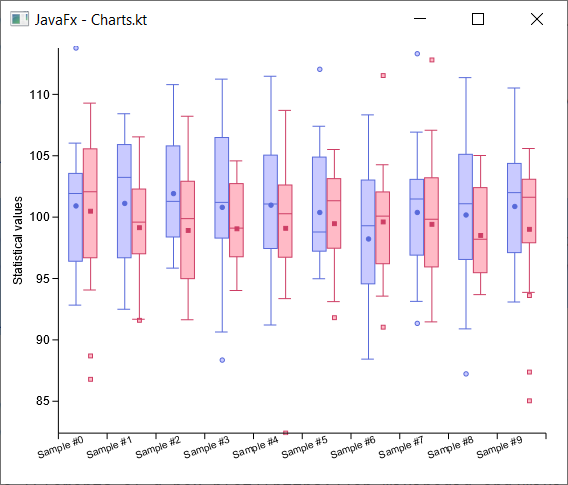I cannot seem to make an account on that site, but I can drop all the code necessary to run in on that site right here. It’s based on the boxplot sample on play.data2viz, but a bit generalized to allow for grouping etc. It’s a bit messy, but it’ll provide something to work with for you. The wanted result is that the boxplots appear stacked next to each other within a group.
import io.data2viz.charts.*
import io.data2viz.charts.core.*
import io.data2viz.charts.core.Labelled
import io.data2viz.charts.dimension.*
import io.data2viz.charts.chart.*
import io.data2viz.charts.chart.mark.*
import io.data2viz.charts.viz.*
import io.data2viz.charts.layout.*
import io.data2viz.geom.*
import io.data2viz.color.*
import io.data2viz.random.RandomDistribution
import io.data2viz.timeFormat.*
import io.data2viz.timeFormat.TimeLocale
import io.data2viz.random.RandomGenerator
import kotlinx.datetime.*
import io.data2viz.math.*
// actual implementation
enum class Type {
A, B, C
}
data class SomeResult(
override val value: Double,
val version: Int,
val type: Type,
) : CanBecomeBoxPlotDataItem<SomeResultPlot> {
companion object : CanBecomeBoxPlotDataItemDualGroupingCompanion<Int, Type, SomeResultPlot> {
override fun toSpecificBoxPlotDataItem(item: BoxPlotDataItem<Int>, secondGrouping: Type): SomeResultPlot =
SomeResultPlot(
secondGrouping = secondGrouping,
item = BoxPlotDataItemImpl(item),
)
}
}
data class SomeResultPlot(
val secondGrouping: Type,
val item: BoxPlotDataItemImpl<Int>,
) : BoxPlotDataItem<Int> by item
fun main() {
val width = 850.0
val height = 600.0
val vc = newVizContainer().apply {
size = Size(width, height)
}
val versions: List<Int> = listOf(1, 2, 3, 4, 5)
val data: List<SomeResult> = versions.flatMap { version ->
Type.values().flatMapIndexed { i, type ->
((i * 20)..(i * 20 + 50)).map { value ->
SomeResult(
value = value.toDouble(),
version = version,
type = type,
)
}
}
}
val plotResults: List<SomeResultPlot> = getBoxPlotResults(
iterator = data.iterator(),
firstGrouping = { it.version },
secondGrouping = { it.type },
toSpecificBoxPlotDataItem = SomeResult.Companion::toSpecificBoxPlotDataItem,
)
vc.chart(plotResults) {
val versionDimension = discrete({ domain.groupingValue }) {
name = "Version"
}
val typeDimension = discrete({ domain.secondGrouping }) {
name = "Type"
}
val valueDimension = quantitative({ domain.median }) {
name = "Value"
}
series = typeDimension
boxPlot(versionDimension, valueDimension) {
maximum = { domain.maximum }
minimum = { domain.minimum }
upperQuartile = { domain.upperQuartile }
lowerQuartile = { domain.lowerQuartile }
outliers = { domain.outliers }
}
}
}
// BoxPlotHelpers
interface CanBecomeBoxPlotDataItem<T : BoxPlotDataItem<*>> {
val value: Double
}
interface CanBecomeBoxPlotDataItemDualGroupingCompanion<G1, G2, T : BoxPlotDataItem<G1>> {
fun toSpecificBoxPlotDataItem(item: BoxPlotDataItem<G1>, secondGrouping: G2): T
}
interface CanBecomeBoxPlotDataItemCompanion<G1, T : BoxPlotDataItem<G1>> {
fun toSpecificBoxPlotDataItem(item: BoxPlotDataItem<G1>): T
}
inline fun <reified T : BoxPlotDataItem<G1>, S : CanBecomeBoxPlotDataItem<T>, reified G1> getBoxPlotResults(
iterator: Iterator<S>,
noinline firstGrouping: (S) -> G1,
noinline toSpecificBoxPlotDataItem: (boxPlotItem: BoxPlotDataItem<G1>) -> T,
): List<T> = getBoxPlotResults<T, S, G1, G1>(
iterator = iterator,
firstGrouping = firstGrouping,
secondGrouping = firstGrouping,
toSpecificBoxPlotDataItem = { boxPlotItem: BoxPlotDataItem<G1>, _: G1 ->
toSpecificBoxPlotDataItem(boxPlotItem)
},
)
inline fun <reified T : BoxPlotDataItem<G1>, S : CanBecomeBoxPlotDataItem<T>, reified G1, G2> getBoxPlotResults(
iterator: Iterator<S>,
noinline firstGrouping: (S) -> G1,
noinline secondGrouping: (S) -> G2,
noinline toSpecificBoxPlotDataItem: (boxPlotItem: BoxPlotDataItem<G1>, secondGrouping: G2) -> T,
): List<T> = iterator
.asSequence()
.groupBy(firstGrouping)
.flatMap { (firstGroupingValue, it) ->
it.groupBy(secondGrouping)
.map { (secondGroupingValue, values) ->
toSpecificBoxPlotDataItem(
getBoxPlotResults(firstGroupingValue, values),
secondGroupingValue,
)
}
}
.toList()
fun <S : CanBecomeBoxPlotDataItem<*>, G1> getBoxPlotResults(
firstGroupingValue: G1,
values: List<S>,
): BoxPlotDataItem<G1> {
val orderedValues = values.sortedBy { it.value }.map { it.value }
val median = median(orderedValues)
val lowerQuartile = median(median.lowerList)
val upperQuartile = median(median.upperList)
val iqr = upperQuartile.medianValue - lowerQuartile.medianValue
val outlierThreshold = iqr * 1.5
val outlierThresholdMin = median.medianValue - outlierThreshold
val outlierThresholdMax = median.medianValue + outlierThreshold
val outliers = orderedValues.filter { it < outlierThresholdMin || it > outlierThresholdMax }
val minimum = lowerQuartile.lowerList.firstOrNull { it >= outlierThresholdMin }
?: orderedValues.first { it >= outlierThresholdMin }
val maximum = orderedValues.lastOrNull { it <= outlierThresholdMax }
?: upperQuartile.upperList.last { it <= outlierThresholdMax }
val mean = orderedValues.sum() / orderedValues.size
return BoxPlotDataItemImpl(
groupingValue = firstGroupingValue,
minimum = minimum,
maximum = maximum,
median = median.medianValue,
lowerQuartile = lowerQuartile.medianValue,
upperQuartile = upperQuartile.medianValue,
mean = mean,
outliers = outliers,
)
}
interface BoxPlotDataItem<G1> {
val groupingValue: G1
val minimum: Double
val maximum: Double
val median: Double
val lowerQuartile: Double
val upperQuartile: Double
val mean: Double
val outliers: List<Double>
}
data class BoxPlotDataItemImpl<G1>(
override val groupingValue: G1,
override val minimum: Double,
override val maximum: Double,
override val median: Double,
override val lowerQuartile: Double,
override val upperQuartile: Double,
override val mean: Double,
override val outliers: List<Double>,
) : BoxPlotDataItem<G1> {
constructor(other: BoxPlotDataItem<G1>) : this(
groupingValue = other.groupingValue,
minimum = other.minimum,
maximum = other.maximum,
median = other.median,
lowerQuartile = other.lowerQuartile,
upperQuartile = other.upperQuartile,
mean = other.mean,
outliers = other.outliers
)
}
data class Median(
val medianValue: Double,
val lowerList: List<Double>,
val upperList: List<Double>,
)
fun median(values: List<Double>): Median {
val orderedValues = values.sorted()
val vs = orderedValues.size
val mid = vs / 2
val median = if (vs % 2 == 1) orderedValues[mid] else (orderedValues[mid] + orderedValues[
if (mid + 1 >= orderedValues.size) orderedValues.size - 1
else mid + 1
]) / 2.0
var listA = if (vs % 2 == 1) orderedValues.subList(0, mid) else orderedValues.subList(0, mid + 1)
if (listA.isEmpty()) listA = listOf(orderedValues.first())
var listB = orderedValues.subList(mid + 1, vs)
if (listB.isEmpty()) listB = listOf(orderedValues.last())
return Median(medianValue = median, lowerList = listA, upperList = listB)
}







